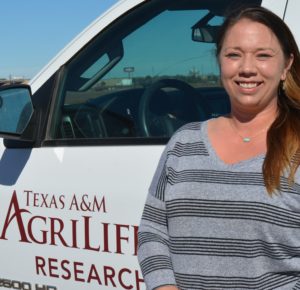Lubbock AgriLife Research soil scientist seeks optimum soil fertility solutions
Writer: Steve Byrns, 325-653-4576, [email protected]
Contact: Dr. Katie Lewis, 806-746-6101, [email protected]
LUBBOCK – Dr. Katie Lewis is going for the triple-whammy against negative soil fertility issues on the Texas High Plains.
When it comes to applying fertilizer, Lewis, a Texas A&M AgriLife Research soil scientist at Lubbock, is seeking to optimize its positive aspects while easing the sometimes negative effects on farmers’ wallets and the environment.
“As a soil fertility program, we are constantly evaluating new fertilizer formulations in terms of efficiency and cost effectiveness, but there is also a strong environmental aspect to our research,” Lewis said. “It is really quite amazing to me the amount of new technology that’s becoming available. I think in coming years we are going to see much improvement in fertilizer-use efficiency, not just based on the source we are using, but also through associated management tools.”

With cover crops becoming more of a common practice, Lewis said it’s important to learn how to appropriately fertilize in those systems, so she is currently involved in looking at nitrogen management within a no till system.
“Being a farmer’s wife, I know all too well that budgets are tight when it comes to crop production; fertilizer can be a major input cost,” she said. “If we can better manage the fertilizer we are applying, we may be able to cut our input costs, and also limit nutrient runoff situations or leaching of nitrogen through our soil profile, which can lead to serious environmental issues.
“Nitrates entering our groundwater can be a major concern, especially here on the High Plains where we are dependent on groundwater as our primary drinking water source. Luckily, in our area this isn’t as common a problem as it is in other parts of the U.S.”
Lewis concedes the Texas High Plains is a long way from the Gulf of Mexico, but surface runoff entering a river may eventually wind up in a larger body of water, possibly leading to eutrophication. Eutrophication, she said, is when excessive nutrients in a body of water such as the Gulf, cause a dense growth of aquatic plant life, which kills fish and other animals by limiting oxygen in the water.
“High levels of nitrates in groundwater and algal blooms in surface water are negative effects of over fertilization and poor management,” Lewis said. “One of the goals of our program is to reduce the amount of fertilizer we’re applying by increasing the efficiency of that fertilizer. Increased efficiency may come from using new formulations and/or adding stabilizer products to the fertilizer, but most importantly, it will come from proper management practices.
“Proper management may mean just managing what we are currently doing a bit better. Rather than putting all of your nitrogen out in one application, we are looking at multiple smaller applications over several months in cotton following wheat cover compared to nitrogen fertilizer with an added stabilizer product, which may allow the crop to better use the product, resulting in less potential loss from the system.”
“With an ammonium-containing fertilizer, something like UAN 32-0-0 for example, bacteria in the soil oxidize ammonium to form nitrites and nitrates through the nitrification process,” she said. “Nitrate is one of the forms of plant available nitrogen but it is also the most mobile and reactive form of nitrogen in the soil, thus has the greatest loss potential. A large rainfall event can leach the nitrate away from the plant’s root zone and saturated soil can lead to gaseous losses of nitrogen via denitrification. But with these new products, we can temporarily inhibit the nitrification step, meaning N fertilizer stays in the form of ammonium longer for the plants to absorb.”
Plants can take up ammonium just like they can nitrates and use less energy in the process, Lewis said, so the product is not reducing the amount of plant-available nitrogen, but rather keeping it in the ammonium form, which has less potential for loss.
The stabilizing product will raise the cost some, she said, but could balance out costs since less fertilizer should be needed and the product’s stabilizing properties, coupled with less product, could reduce the potential negative environmental aspect.
So the take home message Lewis has for farmers wanting the most bang for their buck is the same one Texas A&M AgriLife Extension Service county agents have touted for years…take a soil sample and get it tested.
“Go out, sample your fields, know what residual nutrients you have in your soil,” Lewis said. “That’s a key way to reduce the amount of fertilizer you apply. Producers may be surprised at how much nitrogen and phosphorous they may already have in their soil. That simple soil test can cut costs. I think probably the most important thing I can do is encourage growers to get soil samples analyzed before they buy or apply fertilizer. So remember, the old saying that’s still true today, ‘a penny saved is a penny earned.’”
For more information, contact Lewis at 806-746-6101, [email protected] .


